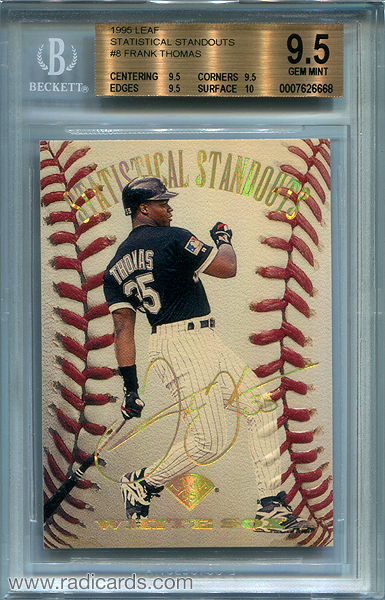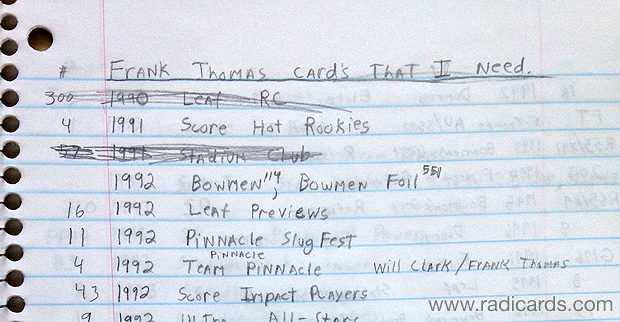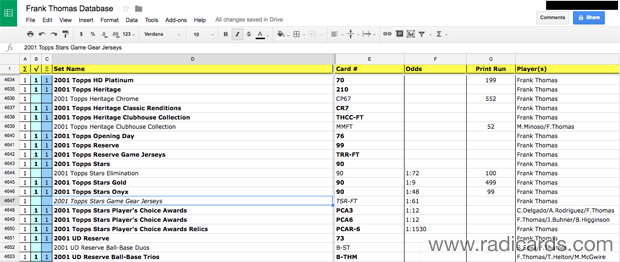
If you’ve been collecting sports cards to any capacity and for any amount of time that garners anything even remotely significant, you need to read this article.
Keeping things organized is a constant battle. The longer you wait to begin this process, the gnarlier it becomes to get it together. Don’t wait too long to begin organizing your collection. As it grows, you’ll find it harder and harder to motivate yourself to work on it while at the same time, it’ll take longer and longer to complete the work. This is a layered outcome with each layer adding more work and time. To avoid this setback, start thinking about how you want to access your cards should you need to reference them. There’s no wrong answer but some answers are better than others.
Don’t be one of those guys that makes any of or variations of the following annoying statements:
- “I know I have it but I have to find it.”
- “It’s around here somewhere; I just have to dig it up.”
- “I may have sold or traded it; I don’t know. I’ll keep an eye out for it.”
These statements are made as a result of poor planning. That’s not so much of an insult or judgement as it is an observation. I’m guilty of losing track of cards. When I had my collection spread across multiple states, I had a difficult time remembering where stuff was located. I had my Thomas collection spread across multiple boxes of varying sizes and in different types of cases. It was a total mess and I sucked at collecting because of it. This happens sometimes and more frequently as your collection grows. If you can commit even a little bit of time to organizational maintenance on a regular basis, it will help you know where stuff is located and it will improve the quality of your negotiations. Two aspects I think any collector can appreciate.
Here’s where it gets interesting. The question we need to consider is one of identifying how we are going to organize the collection. There are countless ways to do this. My advice, and coming from someone who has tried almost everything over the years is to find something that makes logical sense and complements the way you think. Here are examples of what I’m talking about:
- If you collect Through the Mail (TTM) autographs that span over multiple sports and years, it would make sense to organize your collection by sport, then year, then brand, then by card number. For optimal storage, go solely penny sleeves and 3200ct boxes. You’re the only one handling your collection so there’s no need for anything more extravagant.
- If you’re a player collector, I’ve found the best way to keep it all together is to organize by year, then by brand and card number. Don’t discriminate your collection by separating stuff and putting certain cards in thicker cases as supposedly defined and justified by an artificial validation based on some arbitrary parameter i.e., cards worth $20+, autos, gu, etc., and putting them in different boxes, binders, etc. This just complicates things, costs you more money, and takes up more space. There’s no need for any of this since you’re the only one handling your collection. Pick one location and put the entire collection there. If you need to access a certain card, you know exactly where it is, every time. The only items that should be segregated are graded cards and for the obvious reason that their cases are large and need to be housed in separate proprietarily sized boxes. For optimal storage for everything else, go with the triple protection strategy – penny sleeve, toploader, fitted toploader bag. Store them in Super Shoe boxes.
- If you collect a certain team, organize them by year, then by brand and card number. This will augment accessibility and save you a ton of time. For optimal storage, go solely penny sleeves and 3200ct boxes. As stated in the TTM section, you’re the only one handling your collection so there’s no need for anything more extravagant.
Try to focus on a Less is More mindset. What I mean by this is that it will work in your favor to have a simple method for archiving your collection. Avoid using many different types of cases and boxes. Adopt and stick to a consistent approach. And for goodness sakes, people, do yourself a big favor and label your boxes and binders. This will serve you well as you progress as a collector. Things will be easy to find and your collection will look professional. You’ll appreciate this and it may even make you more excited about collecting in general, which is an excellent tertiary benefit.
Okay, now that you’ve organized your physical collection, let’s talk about what you can do to track your collection progress. This is important to avoid double buying i.e., overspending on stuff you already have. I’m talking about creating a checklist of what you have and what you need. There are several ways to do this; some ways are more efficient than others. I’ll explain each in detail; here’s the rundown of candidates in order of efficiency with the first being the least efficient:

- Mental Record: Sure, fine if you have a small collection but as it grows, it will become nearly impossible to remember everything you have. This is the least efficient and only recommended when your collection is in its infancy. As it grows, you’ll want to get yourself into something more tangible.
- Handwritten Checklist: Ahh, the ol’ pencil and pad. I used to create checklists with nothing more than a pencil and spiral notebook. This is cute if you like carrying stuff around. This can be handy and definitely a step up from not having anything at all. Seeing your collection on paper and checking stuff off as you go is really helpful. There are issues here though. Adding cards to the checklist archive can be a pain since you can’t move lines up or down. The other problem is the risk of loss. Keeping track of the written document is a chore but losing it and having to recreate it is a big headache that we want to avoid.
- Microsoft Word: This is a step up from the written physical document. Now you can track what you have and what you need. You can delete, bold, italicize, and move lines up and down. You can also copy and paste, which is a handy feature when you want to relocate a line of data in your checklist. With the use of tables, you can make your checklist look professional. The setbacks here are that doing a physical count can only be done manually, formulas cannot be applied, and you’re unable to freeze rows and columns. Documents can be stored locally or on G-Suite as a Google Doc. If storing locally, there’s a chance of losing it.
- Microsoft Excel: We’re getting hotter. Microsoft Excel is a beautiful and power program. It’s perfect for creating checklists. You can use formulas to auto-calculate totals of stuff you have, stuff you need, stuff that’s been scanned, how much you paid for stuff, etc. You can easily relocate lines of data while still maintaining formula structure. Anything can be colored quickly and simply. Documents can be stored locally or on G-Suite as a Google Sheet. If storing locally, there’s a chance of losing it.
- Google Sheet (G-Suite): This is the ideal approach for tracking your collection on a checklist. You can edit everything just as if it were on a Microsoft Excel sheet but now it’s stored in the cloud, which means it’s forever protected. Content is accessible from any device, which means that no matter what happens to your local drive, everything’s still intact and accessible by a simple Gmail login. Access and edit your checklist from your phone wherever you are in the world. Simple, simple, simple.

To Learn How to Convert an Excel File into a Google Sheet, click here.
So why is it so important to keep track of your collection? Well, think about it, the more knowledge you have about your collection, the less you have to think about it. Remember that scene in Indiana Jones and the Last Crusade when Jones Sr. (Sean Connery) tells Jones Jr. (Harrison Ford) that he created the diary so that he wouldn’t have to remember all of the information he put into it. That’s essentially what we’re doing here. Freeing our minds with the freedom to reference its information (the checklist) whenever we want to. Among the many helpful reasons to have a checklist, we’re creating and using one so we can prevent double buying, keep our collection in order, and track progress as we go. These are all important things that will make you a better, more organized collector. I can feel at least partially confident in assuming that that’s something most of us want to achieve.
What strategy works for you? Share it in the comments section.

 Have you visited our store? Click here.
Have you visited our store? Click here.



Here’s how I did it. I keep a website of my wants, but still buy dupes now and then. You just have to file things away as they come in. You can’t dump now and sort later.
http://thecollectivemind.blogspot.com/2016/09/my-card-roomor-room-and-half-actually.html
Good call on filing things as you get them. There have been several instances where I let stacks pile up only to realize my future workload is extensive and time consuming. Once caught up, it’s essential to stay on top of the filing process as you acquire things. Thanks for sharing a comment.